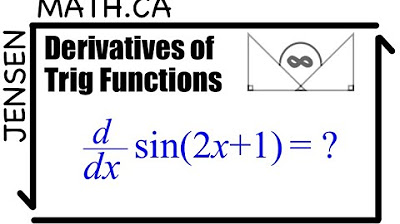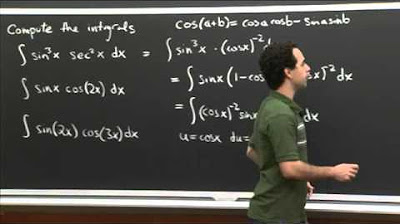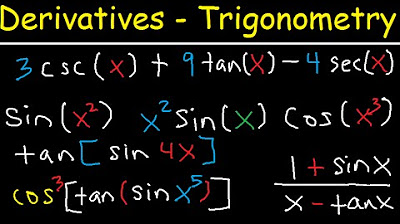Computing Differentials | MIT 18.01SC Single Variable Calculus, Fall 2010
TLDRThis lecture transcript delves into the concept of differentials, a method for tracking derivatives without explicitly writing the variable of differentiation. The instructor demonstrates the computation of differentials for two expressions: one involving a polynomial in terms of 'u', and the other a trigonometric product of sine and cosine functions. The process involves applying the chain rule for the polynomial and the product rule for the trigonometric expression, simplifying the results using basic algebraic manipulations and trigonometric identities.
Takeaways
- 📚 Differentials are an alternative notation for derivatives, used to keep track of changes in functions.
- 🔍 The differential 'd' is distributed across terms in a similar way to ordinary derivatives, but without explicitly writing the variable of differentiation.
- 📐 The chain rule is applied when computing differentials, just as it is with derivatives, to find the change in a function based on the change in its variables.
- 🌟 The differential of a constant is zero, as constants do not change with respect to the variable.
- 🛠️ The differential of a function raised to a power is computed by multiplying the power by the function to the power minus one, and then by 'du', the differential of the variable.
- 🔄 The differential of a product of two functions involves using the product rule, which is analogous to the product rule for derivatives.
- 📈 The differential of sine theta times cosine theta can be simplified using trigonometric identities, resulting in a form involving cosine squared theta minus sine squared theta.
- 🔄 The differential of sine theta is cosine theta times 'd theta', and for cosine theta, it's minus sine theta times 'd theta', following the product rule.
- 📝 The script provides a step-by-step walkthrough of computing differentials for both a polynomial function and a trigonometric function.
- 🧩 The process of computing differentials involves breaking down complex expressions into simpler components, applying the chain rule or product rule as necessary, and then simplifying the result.
- 🔑 Understanding differentials is key to approximating the change in a function's output given a small change in its input, which is fundamental in calculus and various applications.
Q & A
What is the main topic of the lecture?
-The main topic of the lecture is differentials, specifically how to compute them.
What is the first example given in the lecture to compute the differential?
-The first example is to compute the differential d of the expression 7u to the ninth plus 34 minus 5u to the minus third.
What is the process of computing the differential of a constant?
-The differential of a constant is 0, as constants do not change with respect to the variable of differentiation.
How is the differential of a term like 'u to the ninth' computed using the chain rule?
-The differential of 'u to the ninth' is computed by multiplying 9 times 'u to the eighth' and then multiplying by 'du', which is the differential of 'u'.
What does 'du' represent in the context of differentials?
-'du' represents an infinitesimally small change in the variable 'u'.
What is the second example given in the lecture to compute the differential?
-The second example is to compute the differential d of the product of sine theta and cosine theta.
How does the product rule for derivatives apply to differentials?
-The product rule for differentials is the same as for derivatives, but instead of finding derivatives, you find differentials.
What is the differential of sine theta in terms of d theta?
-The differential of sine theta is cosine theta times d theta.
Can the result of the second example be rewritten using trigonometric identities?
-Yes, the result of the second example can be rewritten using trigonometric identities, such as expressing sine theta cosine theta as 1/2 sine of 2*theta before taking the differential.
What is the final expression obtained for the differential of sine theta cosine theta?
-The final expression obtained is cosine squared theta minus sine squared theta times d theta.
What is the significance of differentials in calculus?
-Differentials are significant in calculus as they provide a way to approximate the change in a function based on an infinitesimally small change in its variable.
Outlines
📚 Introduction to Differentials
This paragraph introduces the concept of differentials as a method to compute the rate of change of a function. The instructor encourages students to compute the differentials of two given expressions: 'd of 7u to the ninth plus 34 minus 5u to the minus third' and 'd of sine theta cosine theta'. The paragraph sets the stage for a deeper exploration of differentials and their computation.
🔍 Differential Computation Examples
The instructor provides a step-by-step guide on how to compute the differentials for the given expressions. They explain the process of applying the chain rule to the first expression, simplifying it to '63u to the eighth du' and 'plus 15u to the minus fourth du'. For the second expression, the product rule for differentials is used, resulting in 'cosine squared theta minus sine squared theta d theta'. The explanation emphasizes the similarity between differentials and derivatives, with the main difference being the notation used.
Mindmap
Keywords
💡Differentials
💡Derivative
💡Chain Rule
💡Constant
💡Product Rule
💡Trigonometric Functions
💡Theta
💡Recitation
💡Power Rule
💡Trigonometric Identities
Highlights
Introduction to differentials and how to compute them.
Computing the differential d of 7u^9 + 34 - 5u^(-3).
Computing the differential d of sine theta * cosine theta.
Differentials as a notation for derivatives.
Differentials do not include the 'with respect to' variable.
Distributing differential d through an expression using chain rule.
Applying the chain rule to d of u^9 results in 9u^8 * du.
Constant 34 in differential expression results in 0.
Applying power rule to d of u^(-3) to get -3u^(-4) * du.
Simplifying the differential of the first example to 63u^8 * du + 15u^(-4) * du.
Using the product rule for differentials in the second example.
Differentials follow the same rules as derivatives.
Factoring out d theta in the differential of sine theta * cosine theta.
Rewriting the differential as cosine^2 theta - sine^2 theta * d theta.
Alternative approach using trig identities for sine theta * cosine theta.
Summary of differentials and their computation methods.
Transcripts
Browse More Related Video

Derivatives of Trig Functions - Calculus | MCV4U

DERIVATIVES that keep getting HARDER 🤯 | jensenmath.ca

5.2.3 Identities in Calculus

Trig Integral Practice | MIT 18.01SC Single Variable Calculus, Fall 2010

How do you simplify trigonometric expressions

Derivatives of Trigonometric Functions - Product Rule Quotient & Chain Rule - Calculus Tutorial
5.0 / 5 (0 votes)
Thanks for rating: